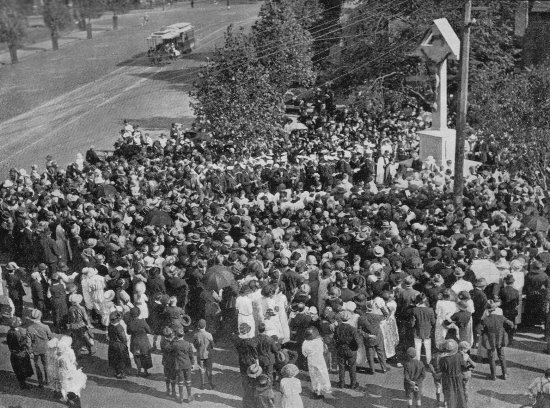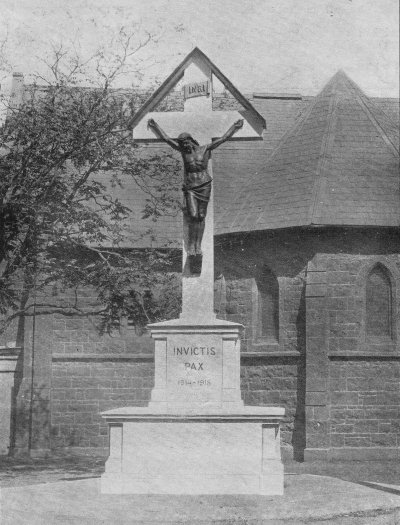The Governor-General's Address
In his stirring address, charged with pathos all the more poignant from the sense of his own personal bereavement through the War, the Governor-General said:–
"In the Unveiling of the Cross of Sacrifice, we signify our remembrance—perpetual as we hope—of the men who, at the call of duty, gave their lives for their country.
Men and women of the British race have passed through many crises in the centuries of its later history; they have fought and suffered and died—sometimes in triumph, sometimes in disaster—sometimes in victory, sometimes in defeat, sometimes merely by the way—doing what they could and without much to show for it. And here and there in the Old Country—and only here and there—are monuments to their memory, inspiring their successors to follow in their train.
They were comparatively few in number, because the opportunity of service was restricted, and so the Memorials to their memory are comparatively few and far between.
But in the Great War things were different. Then it was not the opportunity of the chosen few; it was the nation's call to everyone who had the necessary physical fitness to serve. The opportunity of service was greater because the crisis was greater—the danger was greater—the consequences of defeat would have been more disastrous. So the number of those who went, and the number of those who came not back was greater than ever before, and it is right and fitting that we should honour their memory, and the Victory that they won.
It has been my privilege to take part on many occasions such as this, and to speak about the memorial itself, or the heroic service, the undaunted and undauntable bravery, the steadfast courage and fortitude under circumstances of unbelievable horror and hardship of those whose names are commemorated. To take part in such occasions is an honour I treasure beyond words. I know how much the Empire owes to them, and I value the opportunity of ackowledging it.
But what we do here to-day goes far beyond the mere record of the names of those who fought for us, suffered for us, died for us. We commemorate the spirit in which these great things were done, the spirit of self-sacrifice, the spirit which moved men to throw away all they had in order to go and serve.
They did not stop to ask: 'What shall I get out of it?' The two questions—the one asked—the other stopping at their lips—which occurred to them were: 'Shall I be in time?'—'Shall I make good?'—'Shall I be worthy of the great opportunity?'—'Shall I be able to maintain the great traditions won by the British race in arms?'
The pages of history will record the undying story of their triumph. So long as the British race lasts, their fame shall live.
What, then, is the need of what we do to-day, and what is its significance? Surely we have only to look upon the Memorial to realise its significance—the commemoration of the spirit of service and self-sacrifice—the service and self-sacrifice of men humbly following in the steps of Christ the Saviour of mankind.
I cannot express its true significance better that by quoting some of those beautiful words of the hymn which we sang at the beginning of the Service—words written in the early days of the War by John Arkwright, a friend of mine, a fellow member of the House of Commons:–
- Long years ago, as earth lay dark and still,
- Rose a loud cry upon a lonely hill,
- While in the frailty of our human clay,
- Christ, our Redeemer, passed the self-same way.
Still stands His Cross from that dread hour to this,
- Like some bright star above the dark abyss:
- Still, through the Veil, the Victor's pitying Eyes
- Look down to bless our lesser Calvaries.
O risen Lord, O Shepherd of our dead,
- Whose Cross has bought them and Whose Staff has led—
- In glorious hope their proud and sorrowing land
- Commits her children to Thy gracious Hand.
As the years roll by and this generation passes hence, all the pain and the suffering and the sorrow of the War will vanish away, and there will remain nothing but the fame and the glory of great deeds.
Then shall these memorials throughout the land inspire successive generations with the splendid spirit in which these great things were done.
And so, commemorating our Beloved Dead, we turn to the Sign of HIM by Whose self-sacrifice they have passed through the Veil into the peace and glory of the Life Immortal."
The meeting closed with the singing of the well-known Kieff Melody, commonly known as the Russian Contakion of the Departed.
The Service in the Church
Meanwhile, as the Hall was not large enough to accommodate the crowd that tried to press in, a Service was held in the Church concurrently with that in the Hall.
It began with the singing of the Old Hundredth Hymn.
The Archbishop then addressed the congregation that filled the Church from end to end.
In his touching address, the Archbishop sought to recall the familiar spectacle of Wayside Calvaries, which met the soldier at every turn on the battle fields of Europe, and interpreted their symbolism. He then drew the attention of his audience to the famous battle-song which they had sung a few moments before, and the fitness of the old tune of "John Brown's Body" as set to the inspiring words of the American authoress. Finally, he dwelt with some emphasis on the comfort derived from the teaching as to the future life which both the song and the hymn embodied.

The End of the Service
The service closed with a brief commemoration of the fallen soldiers and a dedication to the task of spiritual renewal as a preparation for the coming of the Holy City, the new Jerusalem, followed by the Benediction pronounced by the Archbishop.
Thus ended an event memorable among many memorable happenings at St. Peter's, yet destined, it may be, to achieve results of abiding worth for the religious life of the community.
Our Cross of Sacrifice is lifted up on the topmost point of Melbourne for all to see. The Saviour's pain-racked arms are outstretched as if to fold the passer-by in His loving embrace; the parched lips seem to say with pleading tones: "Is it nothing to you, all ye that pass by?" He sees—but will he heed that stupendous appeal of Incarnate Love? God knows.
For ourselves, we have raised the symbol of our Redemption for others to take knowledge, but dare we take the message home to ourselves, and, in the power of the Cross, translate it into lives of service and sacrifice for the advancement of the Kingdom?
So only may we justify our claim to erect such a memorial.

The Cross of Sacrifice
This text, and the accompanying photographs, have been transcribed from a contemporary booklet published by Ramsay Publishing Pty. Ltd., Melbourne. Neither the author nor the photographer are identified in the source booklet.
Top
Authorized by the Vicar
(vicar@stpeters.org.au)
Maintained by the Editorial Team
(editor@stpeters.org.au)
© 2013 St Peter's Church